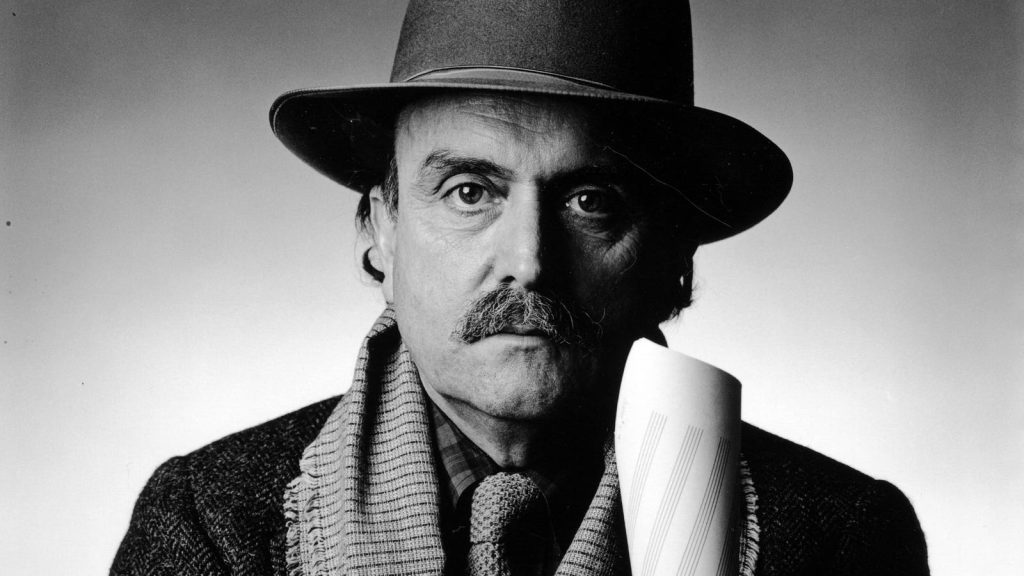Groundbreaking composer Alvin Lucier, pictured in 1986, experimented often with the physical … More
Getty Images
Legendary avant-garde composer Alvin Lucier died in 2021 — but that hasn’t stopped him from making new music. Credit an artificial “brain,” grown from his own cells, that emits sound-triggering electrical signals.
This in-vitro structure lives at the Art Gallery of Western Australia in Perth. There, through Aug. 3, visitors can wander through “Revivification,” an immersive installation that merges sound and biotechnology to imagine a compelling way creativity could, potentially, live on long after artists die.
If you’re picturing a Franken-Lucier rising from an operating table to conduct a symphony, science isn’t there yet (at least not publicly). The provocative installation features tiny 3D organoids, sealed and displayed on a raised pedestal, that resemble a developing human brain. Their neural activity sends signals that activate electromechanical mallets to strike 20 curved, wall-mounted brass plates, sending ambient sound rippling through the gallery in real time.
Curved brass plates surround visitors to “Revivification,” an immersive installation that keeps the … More
Art Gallery of Western Australia
Lucier, who taught at Wesleyan University in Connecticut for decades, was himself intrigued with the physics of sound, and before he died at 90, played an active role in imagining various ways his creative spirit could outlive his physical body.
“The goal of ‘Revivification’ goes beyond simply preserving Alvin Lucier’s music or creating a tribute to his work,” Guy Ben-Ary, Nathan Thompson and Matt Gingold, the three Australian artists who collaborated with him on the project, wrote in a joint response to my interview questions. “Our project aims to fundamentally reimagine artistic immortality by creating a living extension of Lucier’s creative essence.”
The installation, five years in the making, poses intriguing questions: Can creativity exist outside the body? Does creativity retain our uniqueness after we’re gone? Artificial intelligence and holograms are already bringing dead artists back to life, but “Revivification” veers into the realm of biological intelligence to explore a new path for extending artistic legacy through living matter that functions as a surrogate performer.
“This living entity doesn’t merely recreate Lucier’s past compositions but continues his artistic journey through its own biological agency,” the artists said. “It responds to its environment, adapts over time and generates new compositions that couldn’t have been predicted by Lucier himself or by us.”
Organoids made from Alvin Lucier’s biological matter at the 82-day mark. The tiny blobs went on to … More
University of Western Australia
Lucier was one of the first artists to use brainwaves to compose and perform music — for his 1965 piece “Music for Solo Performer” — and he reveled in creating unpredictable soundscapes from everyday objects. Performers of his 1977 “Opera With Objects,” for example, tap two pencils together while touching them to various things — a matchbox, a jar, a plate — to produce a surprisingly shape-shifting acoustic experience.
“Your task is to make vivid for listeners the natural amplification inherent in physical things,” he told performers of the piece.
Given Lucier’s penchant for the unorthodox, it’s no wonder “Revivification” enthralled him so — he stayed engaged in the details on Zoom calls with the artists until nearly the end of his life. In 2020, when he was 89 and growing increasingly frail, he donated blood to the effort. The artists commissioned Harvard Medical School researchers to reprogram Lucier’s white blood cells into stem cells, capable of differentiating into various types of specialized cells. Then, together with University of Western Australia neuroscientist Stuart Hodgetts, they grew neuronal structures atop a mesh of electrodes that both stimulate them and capture their signals.
Notably, the organoids don’t just produce sound, they receive it. Ben-Ary, Thompson and Gingold created a closed-loop system where microphones in the gallery capture ambient audio, including human voices and the harmonics of hammer against brass, and feed them back to the mini brain. The result is, in essence, a dynamic sonic conversation shaped by the interaction between live humans and the lingering essence of a dead one.
“By being in the space, visitors to the installation are influencing both the sound that others hear there, and the types of stimulations sent back into the organoid,” said the trio, who have worked at the intersection of art, biology and technology for years.
A visitor to the Art Gallery of Western Australia in Perth gets a close-up look at a mini “brain” … More
Art Gallery of Western Australia
Can Cellular Blobs Really Be Creative?
The experiment launches as AI permeates creative fields — some artists celebrate its potential to steer their work in exciting new directions, while others fearing it will impact their livelihoods and possibly the very nature of creativity. So where do white blobs fit into the debate about art’s bounds? They clearly lack consciousness, something many would consider essential to creativity.
“Creativity really has to have a conscious element to it. And I don’t think this particular piece of art is conscious,” Indre Viskontas, a cognitive neuroscientist at the University of San Francisco who studies creativity, told NPR. “Those cells have no intention.”
Still, it’s easy to imagine a day when they might, especially with a new season of dark satirical series Black Mirror here to fill our minds with alarming scenarios of technology’s unanticipated consequences. The artists believe it’s not too early to begin pondering the tangled questions surrogate lab-grown performers such as theirs pose: What rights do we afford them? What are the ethical, philosophical and artistic implications of creating entities that may have the potential to be creative?
“These are just some of the questions we hope people ask themselves while experiencing ‘Revivification,’” the artists said. “We don’t, however, wish to offer any answers to the exciting yet troubling possibilities it poses.”
Twenty wall-mounted curved brass plates in the installation function both as sculptural and sonic … More
Art Gallery of Western Australia

